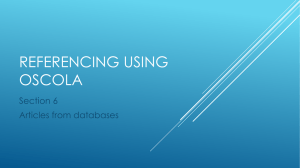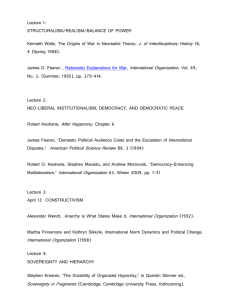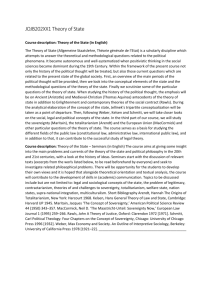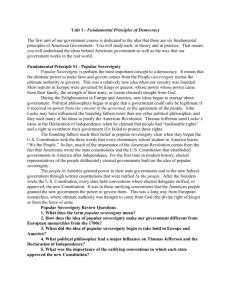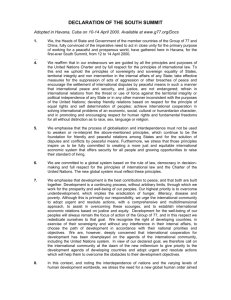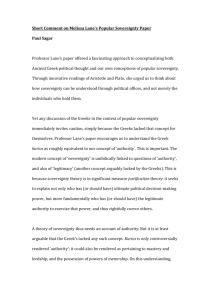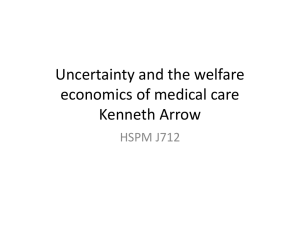Contested Sovereignty Sascha Werthes - EISA
advertisement
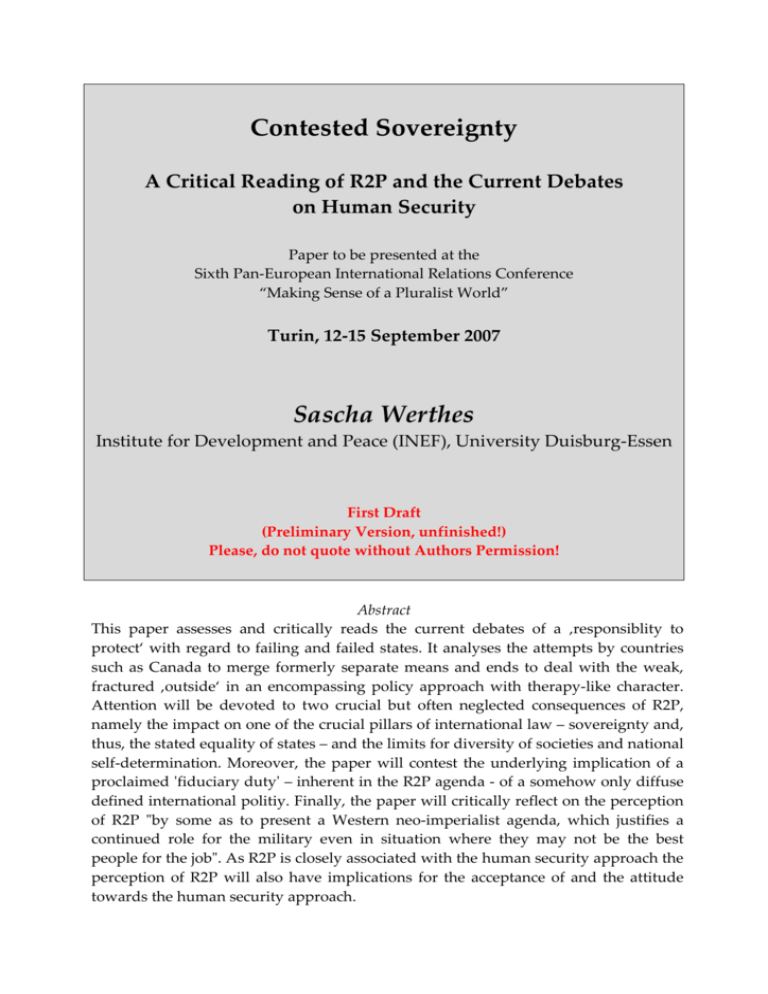
Contested Sovereignty A Critical Reading of R2P and the Current Debates on Human Security Paper to be presented at the Sixth Pan‐European International Relations Conference “Making Sense of a Pluralist World” Turin, 12‐15 September 2007 Sascha Werthes Institute for Development and Peace (INEF), University Duisburg‐Essen First Draft (Preliminary Version, unfinished!) Please, do not quote without Authors Permission! Abstract This paper assesses and critically reads the current debates of a ‚responsiblity to protect‘ with regard to failing and failed states. It analyses the attempts by countries such as Canada to merge formerly separate means and ends to deal with the weak, fractured ‚outside‘ in an encompassing policy approach with therapy‐like character. Attention will be devoted to two crucial but often neglected consequences of R2P, namely the impact on one of the crucial pillars of international law – sovereignty and, thus, the stated equality of states – and the limits for diversity of societies and national self‐determination. Moreover, the paper will contest the underlying implication of a proclaimed ʹfiduciary dutyʹ – inherent in the R2P agenda ‐ of a somehow only diffuse defined international politiy. Finally, the paper will critically reflect on the perception of R2P ʺby some as to present a Western neo‐imperialist agenda, which justifies a continued role for the military even in situation where they may not be the best people for the jobʺ. As R2P is closely associated with the human security approach the perception of R2P will also have implications for the acceptance of and the attitude towards the human security approach. 1. Introduction By directly referring to the International Commission on Intervention and State Sovereignty one argue that the 21st century is – in comparison to the world in 1945 – is characterized by new actors and security issues, new demands and expectations, and new opportunities for common action. New actors have emerged. Not only new states and international institutions but also civil society actors as international non‐governmental organisations have managed to add their voice, perspectives, interests, experiences, and aspirations in discourses about and in the way international relations “are practiced”. The UN High Commissioner for Human Rights and the International Criminal Court are examples of new actors and mechanism in the areas of human rights and human security. The idea of human security itself is an example of how security has or can be reconstructed. It is the vulnerability of civilians which is now addressed as a security issue. Failed states are another example of challenges now addressed as security issues. One can argue that the “current debate about intervention for human protections purposes also takes place in a historical, political and legal context of evolving international standards of conduct for states and individuals, including development of new and stronger norms and mechanisms for the protection of human rights. Human rights have now become a mainstream part of international law, and respect for human rights a central subject and responsibility of international relations” (ICISS 2001: 6). The idea of human security likewise has become an important element in international law and international relations. Finally, sustainable human development has become an important normative goal of international relations. But how can one distinguish human rights, human security, human development policies. And how do “extreme” measures like (military humanitarian) interventions fit in? This paper will give preliminary answers to this question by having a more closer look at the idea of human security and at the report of the International Commission on Interventions and State Sovereignty “The Responsibility to Protect”. 2. Human Security as a Starting Point The history of the idea of human security can certainly be written in various ways. Nevertheless, it is tried here to give a short introduction and rapprochement to the content of and tensions in various conceptions of human security. One can certainly argue that the basis for paying so much attention to ideas which are criticised for being vague and ambiguous is the assumptions that these kinds of interpretative and normative concepts nevertheless significantly influence the perception and action of politicians and the public alike (see MacFarlane/Khong 2006, 3). Surely, the UN was neither the only nor necessarily the most influential entity which had an impact on thinking about and reconceptualizing security at the end of 21st century. Moreover, thinking about the security of individuals and their rights has a long tradition in political philosophy. And certainly various immensely active states, regional organisations, non‐governmental organisations, and academic think tanks have contributed to various reformulations of security. However, it is certainly justified to argue that the starting point of the current debates and discourses on security, which take the individual as the most important referent‐object, can be associated with the UN. The publication of the Human Development Report in 1994 can be seen as the intellectual origin of the idea which came to be knows as human security. 2.1 The Evolution of the Concept The UNDP Report of 1994 came to the conclusion that the complex developmental and security reality challenges at the end of the 20th and the beginning of the 21st century can neither be described nor responded to separate and independently from each other. Arguing that the multidimensional globalisation processes have effected and eroded state sovereignty the UNDP Report concluded that one has to rethink security. Not the state and its territoriality should be the mayor focus of security, but the human individual. In concrete human security should mean the safety from chronic threats such as hunger, disease and repression (Freedom from Fear) and the protection from sudden and hurtful disruptions in the patterns of daily life – whether in jobs in homes, or in communities (Freedom from Want) (UNDP 1994: 23). “Freedom from Fear” and “Freedom from Want” should stand at the centre of international (security) policy. The report argued that: “A concideration of the basic concept of human security must focus on four of its essential characteristics: ‐ Human security is a universal concern. It is relevant to people everywhere, in rich nations and poor. There are many threats that are common to all people – such as unemployment, drugs, crime, pollution and human rights violations. Their intensity may differ from one part of the world to another, but all these threats to human security are real and growing. ‐ The components of human security are interdependent. When security of people is endangered anywhere in the world, all nations are likely to get involved. Famine, disease, pollution, drug trafficking, terrorism, ethnic disputes and social disintegration are no longer isolated events, confined within national borders. Their consequences travel the globe. ‐ Human security is easier to ensure through early prevention than later intervention. It is less costly to meet these threats upstream than downstream. For example, the direct and indirect cost of HIV/AIDS (human immunodeficiency virus/acquired immune deficiency syndrome) was roughly $240 billion during the 1980s. Even a few billion dollars invested in primary health care and family planning education could have helped contain the spread of the deadly disease. ‐ Human security is people‐centred. It is concerned with how people live and breathe in a society, how freely they exercise their many choices, how much access they have to market and social opportunities – and whether they live in conflict or in peace.” (UNDP 1994: 22,23) It is important to note that the UNDP Report differentiates two political realms of human security. One realm, which emphasises the protection against (direct) physical violence referred to as “Freedom from Fear” and another one which emphasises the protection from sudden and hurtful disruptions in the patterns of daily life referred to as “Freedom from Want”. The later addressing issues formerly more attributed to a development policy agenda. But the most “innovative”, the most important new aspect respectively is that this security approach takes the human individual as the central referent‐object, whereas all other security approaches of the 1970ies and 1980ies still somehow referred to the state and its territoriality. As the spectrum of potential security threats is extended not only physical violence but also life‐threatening want is considered a challenge for security policy. Furthermore, the report names seven main categories under which threats to human security can be considered (UNDP 1994: 25‐33): ‐ ‐ ‐ ‐ ‐ ‐ ‐ Economic security; Food security; Health security; Environmental security; Personal security; Community security; Political Security. Basically the central logic of the line of argumentation is that economical development, stability, peace in developing countries or fragile states cannot be sustainable, unless people feel secured. Development and security are interrelated and interdependent. Although, the line of argumentation and analysis of the UNDP that developmental and security challenges are interrelated and interdependent was broadly shared, nevertheless the UNDP approach on human security was widely criticised as being too broad and analytical underdeveloped. So, it would be not possible to separate development policy, human rights policy, and security policy from each other. Moreover, the approach would in no way help to decide which challenges and tasks should be prioritised. These critical reflections might explain why it took until the second half of the 1990s until political actors took up the idea of human security. Indeed, none of these political actors referred to human security in the way the UNDP did. In fact, two variants can be distinguished which emphasised one of the specific political realms. 2.2 Implementing a Human Security Agenda: Two variants One can argue that two variants of human security were politically implemented at the end of the 1990s. One variant can be described as being based on a narrow understanding of human security, which focuses on protection against physical violence. This variant is associated with Canada, the Human Security Network, the Commission on Intervention and State Sovereignty, or the Human Security Report. Freedom from Fear is regarded as the mayor objective of the human security policy. The other variant is associated with Japan and the Commission on Human Security. It is based on a broad understanding of human security. Not only direct physical violence but also indirect violence and all aspect which threaten the vital core and dignity of human beings are considered as security relevant. The inclusion of human dignity as a reference even broadens the original UNDP approach. Central task of a human security is not only protection but also empowerment. These two understandings dominated the critical discourses on human security. Maybe due to the fact that these two political actors (Japan and Canada) tried to implement human security as a doctrine of their foreign policy agendas and the various policy initiatives they started/supported in the name of human security (e.g. the Ottawa Process on banning anti‐personal landmines) (see Bosold/Werthes 2005) further and steady attention was paid to the human security idea. Fig. 1: The Range of Politically Manifest Human Security Concepts If one perceives these two politically implemented different variants more as variants based on distinguishable understandings that are distinguishable only because of different foci or perspectives on human security then one can also argue for a third perspective on human security. 2.3 Human Security and Its Three Perspectives One can easily argue that although distinguishable the above described variants of human security have core elements in common and that they are distinguishable because of the different perspectives they have on human security. This allows distinguishing a third perspective (see Fig. 2 and Tab. 1).1 The third perspective can not so easily be associated with a political actor. Nonetheless, one can argue that the Barcelona Report (“A Human Security Doctrine for Europe”) of the Study Group on Europe’s Security Capabilities illustrates this perspective more or less clearly. With regard to the political agendas and first implementation efforts one can describe the three perspectives as follows. The “Japanese” variant emphasises as the central focus sustainable human development. Economic, social and environmental rights are key elements and should be of high political relevance. Strategies and instruments advocated are: redistributive measures that address inequalities in wealth and income between rich and poor, new participatory governance structures at subnational, national, and global levels. It is axiomatic argued that the root causes of threats to human security are inequality and injustice. This perspective “stresses the non military threats to human security and the threats that have arisen from a wide variety of largely human‐induced problems, such as unchecked global population growth, migration, disparities in economic opportunities (especially the widening gap between the world’s rich and poor), the rise of pandemic diseases (e.g. AIDS), environmental degradation, and new security problems that affect individuals and groups, such as drug trafficking and terrorism” (Hampson et al. 2002: 28). As one can see in Figure 1, this is “a broad view of human security”, but as emphasised by Hampson et al. (2002: 28) it “is also one that stresses the distributive aspects of development and the fact that many of these problems are rooted in socio‐ economic inequalities and a lack of social justice”. Key elements that are politically prioritised are: basic personal rights, including subsistence rights. In contrast, the “Canadian” variant focuses – more narrowly ‐ on securing individuals in war or situations of violent conflict and on providing emergency assistance to those in dire need. Thus it is justified to argue this variant is based on a humanitarian perspective on human security. Strategies and instruments approved are military intervention, humanitarian and emergency assistance in the 1980s and early 1990s and additionally peacebuilding, conflict prevention since the mid 1990s. Strategies and instruments that try to advance sustainable human development are regarded – like in the third perspective – as supportive for human security, but not part of a human security policy as such. They remain in the realm of development policy. Finally, it is important to note that this ‘humanitarian’ perspective highlights most clearly the responsibility of the international community to take care for human security; even though human security is more narrowly conceptualized. But one can argue that it is this narrow and humanitarian accentuation which allows proponents 1 These three views of human security are described in detail by Hampson et al. (2002). of this perspective to claim that interference and intervention can be legitimised in certain situations and under certain preconditions. The third perspective on human security is “what might be called a right‐based approach to human security centred on a fairly broad definition of human security (in the sense of entertaining a wide variety of different legal rights), but nonetheless anchored in the rule of law and treaty‐based solutions to human security” (Hampson et al. 2002: 17). According to the perspective international (and regional) institutions are central to developing new human rights norms and for bringing about a convergence in different national standards and practices. Key elements stressed are: basic personal rights, legal rights, political and civic rights. Typical strategies and instruments suggested are: sanctions, cooptation, shaming, prosecution and conviction (criminal tribunals and International Criminal Court). An illustrative example might be the protection of minorities by minority rights. Figure 2: Three Human Security Perspectives (Compiled by Sascha Werthes, based on ideas by Fen Osler Hampson et al. 2002) Although these perspectives on human security can with regard to their focus, their preferred strategies and instrument be distinguished, one has to concede that this juxtaposing is to a certain degree lukewarm. Moreover, with regard to possibilities to separate and differentiate clearly (human) security, development, and human rights policies from each others there seem still to be long a way to go. Nevertheless, these remarks should have helped to get an idea about human security and its core elements. The central focus and point of reference is always the human individual. This is the certainly the mayor point of difference of human and (traditional) state security. “The point of reference or ‘object’ of security is not the nation‐state and its territory but individual people in their dayly activities, wherever they live, and humanity as collective body in which all individuals are members” (Hampson et al. 2002: 37). Moreover, this “personalization of security entails a recognition that the interests of individual human beings are distinct from, and might even conflict with, those of the states” (ibid.). Finally, these remarks should have served us to see where and how the “Responsibility to Protect” and humanitarian intervention respectively fit in the human security framework. 2.4 How R2P/humanitarian intervention fit in First of all, as table 1 already records, the work of the International Commission on Intervention and State Sovereignty (ICISS) which published the report “The Responsibility to Protect” can be associated with the humanitarian perspective. This is further substantiated by the fact that Canada and, especially its former Foreign Affairs Minister Lloyd Axworthy, initiated and supported the Commission. Basically, as stated in the foreword, the report is about “the so‐called ‘right of humanitarian intervention’: the question of when, if ever, it is appropriate for states to take coercive – and in particular military – action, against another state for the purpose of protecting people at risk in that other state” (ICISS 2001: VII). This question is asked at the background of experiences like Somalia, Bosnia, Rwanda, and Kosovo – and one might nowadays add Haiti and Sudan. Moreover, this quote illustrates that the question of the ‘right of humanitarian intervention’ is unmistakably linked to the accepted challenge to “protect people at risk”. The starting point and central theme of the report is the assumption “that sovereign states have a responsibility to protect their own citizens from avoidable catastrophe – from mass murder and rape, from starvation – but that when they are unwilling or unable to do so, that responsibility must be borne by the broader community of states” (ICISS 2001: VIII). The ICISS report deals with the nature and dimension of that responsibility and tries respectively to answer the questions about “who should exercise it, under whose authority, and when, where and how” (ICISS 2001: VIII). When one reads naively the last two paragraphs it is hard to understand what is so contested, so controversial. It seems intuitive persuading that everyone should have an interest in being protected and therefore should be willing to accept a “responsibility to protect” which serves as a safeguard of this interest. To understand the controversy or why these issues seem to touch a sensitive spot one has to have a more closer brief look at the concept of sovereignty and its implications in a system or society of states. Tab. 1: Three Human Security Perspectives Human Security Perspective Humanitarian Perspective ’(Human‐)Rights‐Based Perspective’ ’Sustainable Human Development Perspective’ Key Agents ‐ Canada ‐ Human Security Network ‐ ‐ ‐ International Commission on Intervention and State Sovereignty (Study Group on Europe’s Security Capabilities) ‐ UNDP ‐ Japan ‐ Commission on Human Security Examples of Strategies and Instruments Key Elements ‐ ‐ Basic personal rights, including subsistence rights Basic personal rights, legal rights, political and civic rights Economic, social and environmental rights ‐ Chapter VII instruments: Military intervention and sanctions; ‐ humanitarian and emergency assistance; ‐ peacebuilding; ‐ conflict prevention ‐ Sanctions: ‐ cooptation; ‐ shaming; ‐ prosecution and conviction (criminal tribunals and International Criminal Court) ‐ Redistributive measures that address inequalities in wealth and income between rich and poor; ‐ New participatory governance structures at subnational, national, and global levels Object of Security Individuals Individuals Individuals (Composed by Sascha Werthes, based on ideas by Fen Osler Hampson et al. 2002) 3. Evolving Global Humanitarian Norms and the Idea of Sovereignty Here it is argued that one can perceive the advancement and development of the ideas of human rights and more lately human security as part of an evolutionary process of evolving global humanitarian norms. Norms that challenge established principles of non‐intervention and non‐use of force of an international system of states when it comes to the question in how far these permit e.g. the United Nations Security Council (SC) to authorize intervention to stop humanitarian emergencies taking place inside state borders (see also Wheeler 2000: 1ff.). 3.1 Sovereignty as Dual Responsibility At this point it is not possible to give a detailed summary of the discussions and discourses around the concept of sovereignty, but here it is important to note that sovereignty is generally seen as one of the basic most important components of contemporary world politics and international relations2 In other words, sovereignty is often “regarded as the enabling concept of international relations whereby states assert not only ultimate authority within a distinct territorial entity but also assert membership of the international community” (Evans/Newman 1998: 504). Even more importantly with regard to the themes of this paper, the classical “doctrine of sovereignty implies a double claim: autonomy in foreign policy and exclusive competence in internal affairs. Internal sovereignty thus refers to a supreme decision‐ making and enforcement authority with regard to a particular territory and population. External sovereignty on the other hand refers to its antithesis: the absence of a supreme international authority and hence the independence of sovereign states” (ibid.). One can argue that while historically the idea of sovereignty appeared to be synonymous with the right to exercise unrestricted power, “the history of the modern states system (which is to say the history of state sovereignty) from the seventeenth century onwards has been a conscious attempt to move away from the apparent rigidity of the early formulation of the doctrine while retaining its more useful characteristics, especially the idea of formal equality which it implies” (ibid.). Nowadays, it is more appropriate to speak of ‘divided sovereignty’ as increasing interdependence, the reciprocal nature of international law and membership of international organizations have changed either through consent or auto‐limitation the practical meaning of sovereignty. The UN and EU clearly can be cited as evident examples. 2 For a more detailed discussion with further references see e.g. Krasner 2001b who distinguishes four usages: domestic sovereignty, interdependence sovereignty, international legal sovereignty, and Westphalian sovereignty (Krasner 2001a: 7ff). With regard to the later discussion of fragile, failed states see also Jackson 1996 and his distinction of negative and positive sovereignty (quasi‐ states and states). It is especially the principle of non‐intervention associated with the (classical) idea of sovereignty which is contested in the discussions about humanitarian interventions and the responsibility to protect. Article 2.1, 2.4, and 2.7 of the UN‐ Charter are here of special relevance: 1. The Organization is based on the principle of the sovereign equality of all its Members. 4. All Members shall refrain in their international relations from the threat or use of force against the territorial integrity or political independence of any state, or in any other manner inconsistent with the Purposes of the United Nations. 7. Nothing contained in the present Charter shall authorize the United Nations to intervene in matters which are essentially within the domestic jurisdiction of any state or shall require the Members to submit such matters to settlement under the present Charter; but this principle shall not prejudice the application of enforcement measures under Chapter Vll. It is therefore not surprising that the ICISS (2001: 7) makes special reference to the UN Charter, when it states: “In a dangerous world marked by overwhelming inequalities of power and resources, sovereignty is for many states their best – and sometimes seemingly their only – line of defence. But sovereignty is more than just a functional principle of international relations. For many states and peoples, it is also a recognition of their equal worth and dignity, a protection of their unique identities and their national freedom, and an affirmation of their right to shape and determine their own destiny. In recognition of this, the principle that all states are equally sovereign under international law was established as a cornerstone of the UN Charter (Article 2.1).” But ICISS (ibid.) also refers to the evolution of humanitarian norms and their effect on (domestic) sovereignty: “However, for all the reason mentioned already, the conditions under which sovereignty is exercised – and intervention is practised – have changed dramatically since 1945. Many new states have emerged and are still in the process of consolidating their identity. Evolving international law has set many constraints on what states can do, and not only in the realm of human rights. The emerging concept of human security has created additional demands and expectations in relations to the way states treat their own people. And many new actors are playing international roles previously more or less the exclusive preserve of states.” Finally, the ICISS (2001: 8) describes its own conclusions as based on a “modern understanding of the meaning of sovereignty”, that is sovereignty implies a dual responsibility: “externally – to respect the sovereignty of other states, and internally, to respect the dignity and basic rights of all the people within the state”, manifested in international human rights covenants, in UN practice, and in state practice itself.3 3.1 The Importance of the Subsidiary Principle But what happens if a state does not fulfil its dual and especially its internal responsibilities? As explained before the report of ICISS is based on a “modern understanding of the meaning of sovereignty” which emphasises that “[s]tate sovereignty implies 3 Interesting and illustrative here: the case studies and the line of argumentation by Wheeler (2000). responsibility, and the primary responsibility for the protection of its people lies with the state itself” (ICISS 2001: XI). But the R2P‐Report is provocative here, as it argues that “[w]here a population is suffering serious harm, as a result of internal war, insurgency, repression or state failure, and the state in question is unwilling or unable to halt or avert it, the principle of non‐intervention yields to the international responsibility to protect” (ibid. XI). Two aspects are of special importance here. Firstly, the responsibility to protect people, emphasised in the “modern” understanding of sovereignty, predominates the principle of non‐intervention of the “classical” understanding of sovereignty. Secondly, attributed to the responsibility to protect is the idea of the principle of subsidiarity. That is, if a state is unwilling or unable to protect its citizens the responsibility to protect is assigned to the international society of states. This becomes even more apparent with the astonishing “openness” to non‐UNSC‐ mandated military interventions. Under specific conditions in specific cases either the “Uniting for Peace” procedure or “action within area of jurisdiction by regional or sub‐regional organizations under Chapter VIII of the Charter” are accepted as alternative options (ICISS 2001: XII). In sum, ICISS (2001: XI) argues that the foundations of the responsibility to protect lie in a) the obligation inherent in the concept of sovereignty; b) the responsibility of the SC, under article 24 of the UN Charter for the maintenance of international peace and security; c) specific legal obligations under human rights and human protection declarations, covenants and treaties, international humanitarian law and national law; and d) the developing practice of states, regional organization and the Security Council itself. 3.2 Two Challenges: Supreme Humanitarian Emergencies and Failed States “As transnational threats grow, states will not only begin to question the Westphalian norms that make clear distinctions between what is domestic and international, but they will also find themselves broadening their concepts of security and defense” (Nye 2007: 273). Although Joseph Nye was primary referring to the threat of transnational terrorism one can see clearly the link to the human security discourses. Furthermore one can substantiate the argument when thinking of the evolution of peacekeeping operation or chapter VII resolution respectively in conjunction with the definition of the UN Security Council of what actually constitutes a threat to peace. But when is direct interference/intervention legitimated in the R2P‐Report? The R2P‐Report distinguishes three variants of the “responsibility to protect”: “The responsibility to protect embraces three specific responsibilities: A: The responsibility to prevent: to address the root causes and direct causes of internal conflict and other man‐made crises putting populations at risk. B: The responsibility to react: to respond to situations of compelling human need with appropriate measures, which may include coercive measures like sanctions and international prosecution, and in extreme cases military intervention. C: The responsibility to rebuild: to provide, particularly after a military intervention, full assistance with recovery, reconstruction and reconciliation, addressing the causes of the harm the intervention was designed to halt or avert.” (ICISS 2001: XI) Surely, the responsibility to react and the possibility of a humanitarian intervention as gained most the attention of these three specific responsibilities as it is certainly the most controversial. The International Commission on Intervention and State Sovereignty argues that military interventions for human protection purposes should be exceptional and extraordinary measures. “To be warranted there must be serious and irreparable harm occurring to human beings, or imminently likely to occur” (ICISS 2001: XII). ICISS names specifically two cases when intervention can be warranted: “A. large scale loss of life, actual or apprehended, with genocidal intent or not, which is the product either of deliberate state action, or state neglect or inability to act, or a failed state situation; or B. large scale ‘ethnic cleansing’, actual or apprehended, whether carried out by killing, forced expulsion, acts of terror or rape.” (ICISS 2001: XII) One can therefore, ascribe the three responsibilities to two thresholds. The first threshold is the threshold of vulnerability. Vulnerability can here be defined as a condition where people are exposed to events and circumstances which are difficult to control, even in the long term. These moreover will contain threats to scarce values and will raise issues about security. Vulnerability is therefore an unacceptable condition, which should be addressed either by means and strategies of prevention or (post‐conflict) peacebuilding. The second threshold is a situation of a (supreme) humanitarian crises or the just cause threshold (Wheeler 2002: 34), described as large scale loss of life and large scale ‘ethnic cleansing’. It is important to note that while a failed state situations might easily help to cross the threshold of vulnerability only the (additional) crossing of the (supreme) humanitarian crises threshold allows (military) interventions to be warranted. Moreover, as figure 3 points out, one can distinguish a sphere of fiduciary duties. It can be described as the domain of domestic sovereignty where nevertheless some international norms (e.g. human rights standards) have substantiated, but violation of the norms currently do not form a basis for legitimating coercive pressure or interference. However, one can argue that once they cross the situation of sensitivity they become a matter of international concern as they affect international relations, by having transnational effect. Figure 3: R2P and its Thresholds Finally, although situations of (supreme) humanitarian crises are accepted as a basis to legitimate (military) interventions, the R2P‐Report names four precautionary principles which should be taken into account before acting: “A. Right intention: The primary purpose of the intervention, whatever other motives intervening states may have, must be to halt or avert human suffering. Right intention is better assured with multilateral operations, clearly supported by regional opinion and the victims concerned. B. Last resort: Military intervention can only be justified when every non‐military option for the prevention or peaceful resolution of the crisis has been explored, with reasonable grounds for believing lesser measures would not have succeeded. B. Proportional means: The scale, duration and intensity of the planned military intervention should be the minimum necessary to secure the defined human protection objective. D. Reasonable prospects: There must be a reasonable chance of success in halting or averting the suffering which has justified the intervention, with the consequences of action not likely to be worse than the consequences of inaction.” (ICISS 2001: XII). The (supreme) humanitarian crises threshold and these four principles are important (theoretical) limits. But only the empirical test that is the future will show if they are strong and practical enough. Currently they only weakly help to invalidate the possible critique that R2P presents a Western neo‐imperialist agenda, which justifies a continued role for the military even in situation where they may not be the best people for the job. The problem is that for now these principles are not concrete enough to be easily applied. For now they are open for subjective interpretation. 4. Conclusion: Responsibilities and Fiduciary Duties The paper hopefully has shown that the ICISS report “The Responsibility to Protect” can be regarded as an exemplary example of a much proclaimed growing recognition worldwide that the protection of human security, including human rights and human dignity, must be one of the fundamental objectives of modern international institutions. By having introduced the reader to the idea of human security and its three perspectives and by addressing the links to the R2P doctrine I tried to show that global humanitarian norms have evolved that challenge the traditional/classical idea of sovereignty. Issues that previously, in classical concepts of sovereignty, remained in the realm of internal states affairs and were sancro‐sanct, are now matters of international political discourses and policies. Figure 4: Responsibilities and Fiduciary Duties One can argue that there exist more or less commonly accepted responsibilities and fiduciary duties which a “modern” state of the 21st century has to fulfil. Whereas in the sphere of fiduciary duties of the state no interference and intervention seem to be legitimate, they seem to be more and more legitimate in the sphere of responsibilities. The three responsibilities of “The Responsibility to Protect”‐Report can be concretized by the human security framework. The narrow conception of human security from the humanitarian perspective allows substantiating the threshold of vulnerability and the threshold of (supreme) humanitarian emergencies. References Annan, Kofi, 2000: Report of the Secretary General on the Work of the Organization, A/55/1, New York: United Nations. Bosold, David/Werthes, Sascha, 2005: Human Security in Practice: Canadian and Japanese Experiences. In: International Politics and Society, 1/2005: 84-101. CHS (Commission on Human Security), 2003: Human Security Now. <www.humansecuritychs.org/finalreport/ index.html, 4.04.07>. Debiel, Tobias / Werthes, Sascha, 2005: Human Security - vom politischen Leitbild zum integralen Baustein eines neuen Sicherheitskonzepts?. In: Sicherheit + Frieden, 1/2005: 714. Evans, Graham/Newnham (1998): Sovereignty. In: Evans, Graham/Newnham (1998): The Penguin Dictionary of International Relations. London: 504-505. Hampson, Fen Osler et al., 2002: Madness in the Multitude. Human Security and World Disorder. Don Mills. Human Security Centre, 2005: Human Security Report 2005. War and Peace in the 21st Century. Vancouver. < www.humansecurityreport.info/content/view/28/63/, 23.07.2007> ICISS (International Commission on Intervention and State Sovereignty), 2001: The Responsibility to Protect: Report of the International Commission on Intervention and State Sovereignty. Ottawa. <www.iciss.gc.ca, 23.07.07>. Jackson, Robert H. (1996, reprint of 1990): Quasi-States: Sovereignty, International Relations, and The Third World. Cambridge. Kaldor, Mary, 2000: Neue und alte Kriege. Frankfurt/Main. [German ed. of New and Old Wars, Oxford: Polity Press.] Kaul, Inge et al. (eds.). 2003: Providing Global Public Goods. Managing Globalization. New York. Krasner, Stephan D. (2001a): Problematic Sovereignty. In: Krasner, Stephan D. (ed.) (2001): Problematic Sovereignty. Contested Rules and Political Possibilities. New York: 1-24. Krasner, Stephan D. (ed.) (2001b): Problematic Sovereignty. Contested Rules and Political Possibilities. New York. MacFarlane, S. Neil/Yuen Foong Khong, 2006: Human Security and the UN. A Critical History. Bloomington, IN. Mendez, Ruben P., 1999: Peace as a Global Public Good. In: Kaul, Inge et al. (eds.): Global Public Goods: International Cooperation in the 21st Century. New York: 382-416. Nye, Joseph S. Jr., 2007: Understanding International Conflicts. An Introduction to Theory and History. 6th ed., New York et al. Paris, Roland, 2001: Human Security. Paradigm Shift or Hot Air?. In: International Security, 26 (2): 87-102. SGESC (Study Group on Europe’s Security Capabilites), 2004: A Human Security Doctrine for Europe. The Barcelona Report of the Study Group on Europe’s Security Capabilities. 15. September 2004, <www.lse.ac.uk/Depts/global/Publications/HumanSecurityDoctrine.pdf, 2.08.07> UNDP, 1994: Human Development Report 1994: New Dimensions of Human Security. <hdr.undp.org, 4.04.07>. Werthes, Sascha/Bosold, David, 2005: Human Security and Smart Sanctions: Two Means to a Common End?. In: International Affairs Review, 14 (2): 111-136. Wheeler, Nicholas J. (2002, paperback, 2000 hardcover): Saving Strangers. Humanitarian Intervention in International Society. Oxford.
